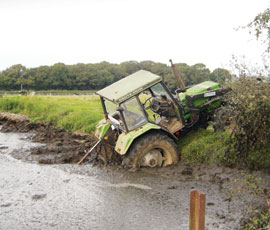Strong warning on farm finances

While 2012 was a tough year for many farm businesses, the worst financial effects may not be felt until later this year, consultant Andersons warned this week.
“Many bank balances don’t look too bad, but this will be a false position in many cases, and trouble will be storing up for the future,’ said Oliver Lee, a consultant in the firm’s Melton Mowbray office.
“Although funding may look adequate at present, many farm businesses could see their bank positions deteriorate rapidly.”
Ironically, arable cashflow had been helped by the fact that large areas of land remain unplanted, saving on input costs, but this threatened longer-term business health.
The latest bank borrowing figures show that in the year to the end of November 2012, farm businesses were borrowing £13.6bn – £1bn more than a year earlier.
George Cook, a senior farm business consultant with The Andersons Centre, urged farmers not to allow matters to reach crisis point with their bank.
Getting on top of the figures now and looking at the likely impact of the past year would allow them to assess borrowing requirements more accurately and so to be in a position to present a well-argued case for the next few months.
“Unfortunately, in the present banking climate, there will be farming businesses which are likely to find their lenders will not support increased borrowing unless they can make a very convincing case.”
Andersons also warned of the danger of capital investment often not being as well thought-through as it needed to be. “Purchase decisions are often driven by the desire to avoid tax or the health of the bank balance rather than the fundamental requirements of what the business needs. Such investment often increases costs of production rather than decreasing them and the effects can be long-lasting.”
Rents under scrutiny
The latest figures from Smiths Gore’s annual agricultural rent database (see table) show that where there has been a change, the average increase was 28%.
While output prices are historically high in some sectors, production costs and rent levels in particular are under increasing scrutiny. Many rural landlords and their agents are taking an unrealistic stance in rent review negotiations, said the TFA.
“We have just been through one of the most difficult years in modern farming history,” said chief executive George Dunn. Some landlords’ agents were living in cloud cuckoo land with regard to expectations of levels of rent achievable on current reviews, he said.
“Tenant farmers would much rather be making good profits and paying good rents to their landlords as a result. However, landlords must accept that in tough times the ability of tenants to pay increased rents will be severely limited.”
Arable rents and rent-equivalents were surging, said Andersons, with dubious justifications for high tenders – budgets based on first wheats at high prices, assumptions that overheads would not rise, extra working capital not accounted for, SPS assumed at current levels and illusions about economies of scale.
| New rents agreed by farm type in year to April 2012 | |||||
| Average rents agreed at rent reviews, re-lettings and new lettings | |||||
| New rent | Old rent | Percentage change | Number of reviews | Area reviewed (acres) |
|
| Arable | 33% | 155 | 36,201 | ||
| Dairy | 16% | 53 | 11,445 | ||
| Livestock | 33% | 206 | 71,268 | ||
| Mixed | 20% | 141 | 39,289 | ||
| Overall average | 28% | 555 | 158,202 | ||
| Source: Smiths Gore |
|
|
| ||
Farm borrowing increases by 10%
